Decoding Crypto Charts: A Beginner’s Step-by-Step Guide
Note: This post may contain affiliate links, and we may earn a commission (with No additional cost for you) if you make a purchase via our link. See our disclosure for more info. The crypto world is constantly changing. This content is for informational purposes only and not financial, legal, or professional advice So, please verify the info on the cryptocurrency provider’s websites.
Did you know that 95% of cryptocurrency traders lose money? This staggering statistic often stems from a lack of understanding when it comes to reading and interpreting crypto charts. As a beginner, you might find the world of candlesticks, support levels, and technical indicators overwhelming. However, mastering the art of chart analysis can greatly improve your trading decisions and potentially boost your profits. By breaking down the complexities of crypto charts into manageable steps, you'll gain the confidence to navigate this volatile market with greater ease. Let's explore how you can reveal the secrets hidden within these digital roadmaps to financial success.
Key Takeaways
- Understand different chart types: line, candlestick, bar, Renko, and Heikin Ashi, each offering unique insights into price movements.
- Learn to read candlestick patterns, focusing on body and wick shapes to interpret market sentiment and potential reversals.
- Familiarize yourself with key chart components: trading pair, current price, high/low range, 24-hour volume, and price chart.
- Analyze various timeframes and intervals to gain a comprehensive view of market trends and align with your trading strategy.
- Identify support and resistance levels to determine potential price floors and ceilings, crucial for setting stop-loss orders and profit targets.
Types of Cryptocurrency Charts
In the world of cryptocurrency trading, various chart types offer unique insights into market behavior. Understanding these different types of charts is essential for effective crypto chart analysis and informed decision-making.
Let's explore the most common chart types used in crypto trading:
- Line Charts: These provide a simple overview of price trends by connecting closing prices over time. They're ideal for long-term investors focused on broader movements.
- Candlestick Charts: The most popular type for crypto trading, candlestick charts display open, high, low, and closing prices. Their color-coded bodies indicate price movements, with green for increases and red for decreases.
- Bar Charts (OHLC): These offer detailed information about price changes, showing opening, closing, high, and low prices for specific time periods. They're useful for analyzing market strength and direction.
- Renko Charts: These filter out time and focus solely on price movement, helping traders identify trends and reversals more clearly by using blocks to represent price changes.
- Heikin Ashi Charts: These modify traditional candlestick charts to provide smoother price data and clearer trend signals by averaging price movements, making them useful for identifying prevailing market trends.
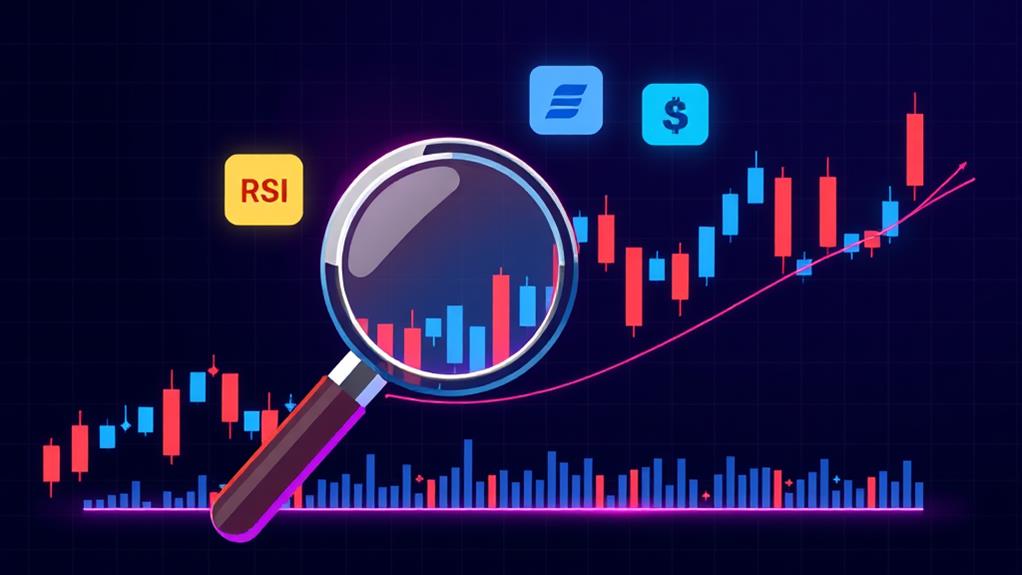
Understanding Candlestick Patterns
You'll find that understanding candlestick patterns is essential for interpreting crypto charts effectively.
To master this skill, you'll need to familiarize yourself with the anatomy of a candlestick, including its body, wicks, and color significance.
As you progress, you'll learn to recognize common candlestick formations and interpret their signals, which can provide valuable insights into potential market movements and help inform your trading decisions.
Anatomy of a Candlestick
Understanding the anatomy of a candlestick is vital for decoding crypto charts effectively. A candlestick represents price movements within a specific time frame, consisting of a body and wicks. The body shows the opening and closing prices, while the wicks indicate the highest and lowest prices during that period.
The color of the candlestick body is fundamental:
- Green (bullish): Closing price higher than opening price
- Red (bearish): Closing price lower than opening price
The length of the body and wicks provides valuable insights:
- Long body: Strong buying or selling pressure
- Short body: Indecision among traders
- Long wicks: Significant price volatility
Recognizing candlestick patterns can help you make informed trading decisions. Common patterns include:
- Doji: Indicates potential market reversal
- Hammer: Suggests a bullish trend
- Shooting Star: Signals a possible bearish reversal
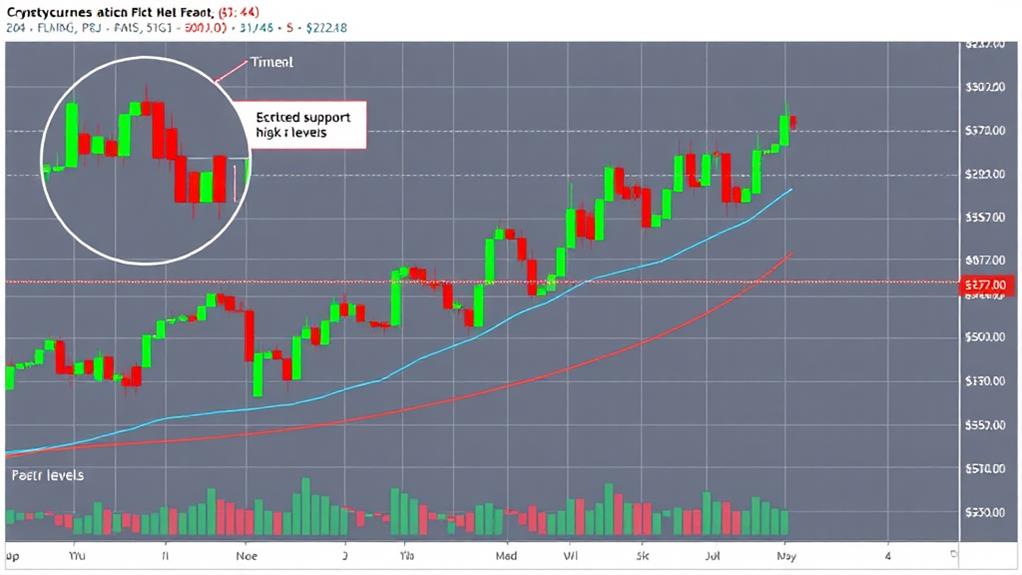
Common Candlestick Formations
Building on the basics of candlestick anatomy, we'll now explore common candlestick formations that can help you predict potential market movements. Understanding these patterns is vital for developing an effective trading strategy. Let's examine some key formations:
| Pattern | Description | Potential Indication |
|---|---|---|
| Hammer | Long lower wick, short body | Bullish reversal |
| Shooting Star | Long upper wick, short body | Bearish reversal |
| Bullish Engulfing | Large green candle engulfs previous red candle | Upward trend |
These patterns can signal potential price movements, but it's important to take into account the time frame when interpreting them. Longer time frames typically provide stronger signals for traders.
Bullish patterns, such as the Hammer, suggest a possible upward trend. When you spot a candlestick with a long lower wick and a short body at the end of a downtrend, it may indicate a bullish reversal.
Conversely, bearish patterns like the Shooting Star can signal a potential downward trend. This formation appears as a candlestick with a long upper wick and a short body at the end of an uptrend.
Interpreting Candlestick Signals
Countless traders rely on candlestick patterns to gain insights into market sentiment and potential price movements. These patterns, formed by the opening and closing prices along with the highest and lowest prices during a specific period, can help you identify bullish and bearish trends in the crypto market.
By understanding how to interpret candlestick signals, you'll be better equipped to make informed trading decisions.
Here are five key aspects to evaluate when interpreting candlestick patterns:
- Green (bullish) candlesticks indicate upward price movement
- Red (bearish) candlesticks suggest downward momentum
- The Doji pattern signifies market indecision
- Engulfing candles can signal potential trend reversals
- Patterns like the Shooting Star may indicate upcoming price declines
When analyzing candlestick patterns, pay attention to their position relative to support and resistance levels. A Doji pattern appearing at a significant resistance level, for example, might suggest an impending trend reversal.
Additionally, look for combinations of patterns to strengthen your analysis. By mastering the interpretation of candlestick signals, you'll enhance your ability to predict future price movements and capitalize on market sentiment shifts in the volatile crypto market.
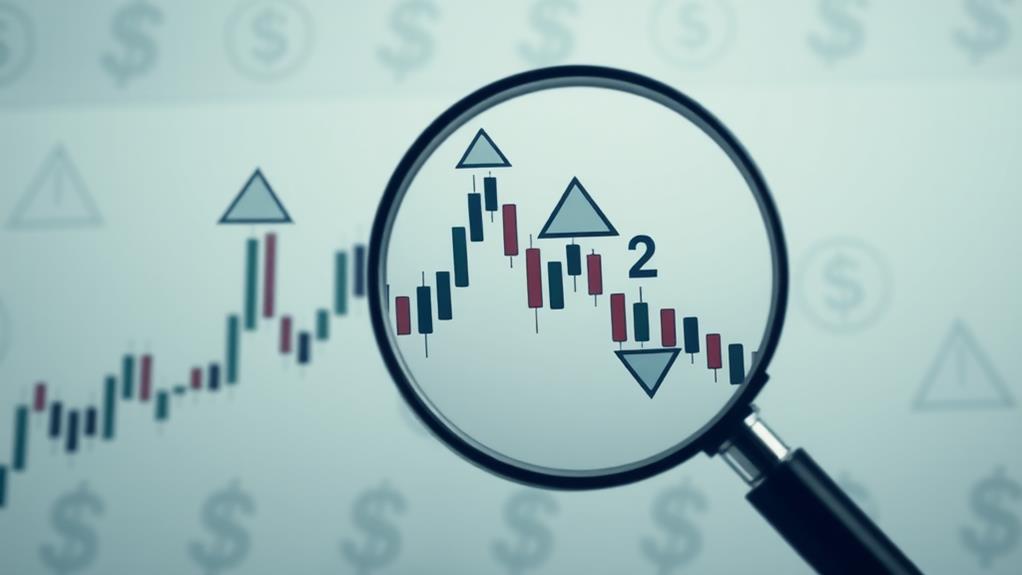
Key Components of Crypto Charts
At the heart of cryptocurrency trading, crypto charts serve as essential tools for investors and traders alike. These charts contain several key components that provide vital information for making informed decisions. Let's explore the essential elements you'll encounter when analyzing crypto charts.
| Component | Description | Importance |
|---|---|---|
| Trading Pair | Base and quote currencies | Indicates relative value |
| Current Price | Real-time asset value | Reflects market activity |
| High/Low | 24-hour price range | Shows market volatility |
The trading pair displays the base and quote currencies, helping you understand the asset's value relative to another. You'll find the current price prominently displayed, offering real-time insights into market activity. High and low indicators reveal the 24-hour price range, giving you a sense of market volatility.
Another important component is the 24H Vol, which shows the trading volume over the past day. This metric helps assess market interest and liquidity. The price chart itself, often using candlestick patterns, visually represents price movements over time. By studying this chart, you can identify trends, potential reversals, and overall market sentiment. These components work together to provide a thorough view of the asset's performance and market conditions.
Analyzing Timeframes and Intervals
When delving into crypto chart analysis, understanding timeframes and intervals is essential for interpreting market dynamics. Timeframes represent specific periods over which price data is displayed, ranging from minutes to weeks.
Different timeframes serve various trading strategies, with shorter ones suited for day trading and longer ones for identifying overall trends. Intervals determine the frequency of price data points within a chosen timeframe, providing detailed views of trading activity.
To effectively analyze crypto charts, consider the following:
- Commonly used timeframes: 1-minute, 5-minute, 1-hour, daily (1D), and weekly (1W)
- Short-term charts capture rapid fluctuations
- Long-term charts reveal broader trends
- Multiple timeframe analysis offers an extensive view
- Intervals affect the granularity of price movements within a timeframe
Identifying Support and Resistance Levels
Support and resistance levels stand out as essential elements in crypto chart analysis, helping traders pinpoint potential price reversal points.
These levels represent psychological barriers where buying or selling pressure intensifies, often leading to breakouts or reversals.
To identify support and resistance levels, you'll need to analyze historical price action. Look for areas where the price has repeatedly bounced or reversed. Draw horizontal lines at significant peaks (resistance) and troughs (support) on your chart to visually mark these critical zones.
Keep in mind:
- The more times a level is tested and holds, the stronger it becomes
- Volume can confirm support and resistance levels
- High volume at these levels indicates strong interest
- Low volume may suggest weak support or resistance
When analyzing crypto charts, pay close attention to price action around these levels. If a support level breaks with high volume, it may signal a continued downtrend.
Conversely, a breakout above resistance with strong volume could indicate an uptrend.
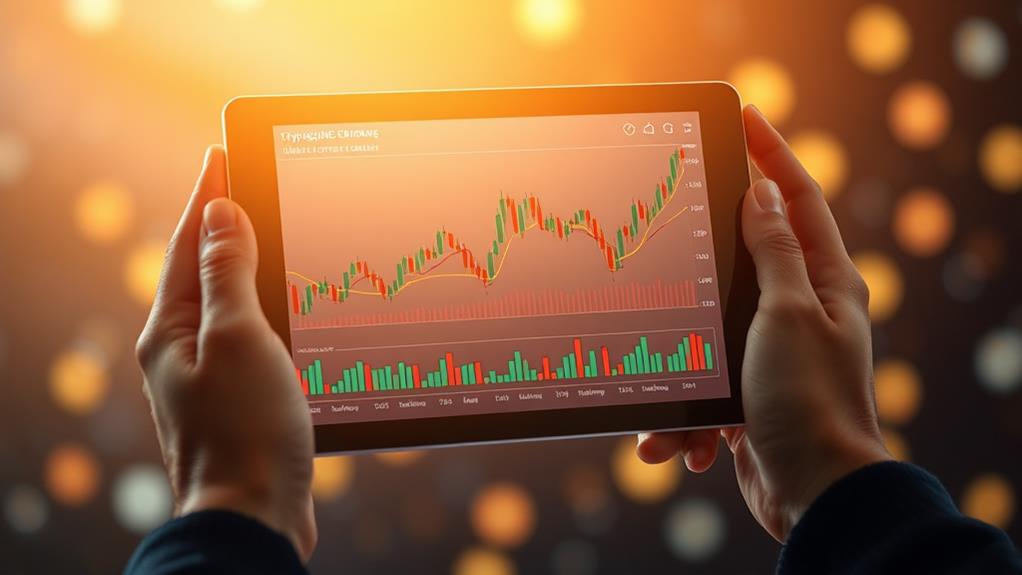
Popular Technical Indicators Explained
Technical indicators serve as essential tools for crypto traders, offering valuable insights into market trends, momentum, and potential reversal points.
These indicators help you analyze price movements and predict potential market behavior. Here are five popular technical indicators used in crypto trading:
- Relative Strength Index (RSI): Measures momentum, signaling overbought conditions above 70 and oversold conditions below 30
- Moving Average Convergence Divergence (MACD): Identifies trend direction and potential reversals using the MACD line, signal line, and histogram
- Stochastic Oscillator: Compares closing price to price range, indicating overbought above 80 and oversold below 20
- Bollinger Bands: Reveal volatility using a middle band and two outer bands, helping identify overbought and oversold conditions
- Fibonacci Retracement: Uses key ratios to identify potential support and resistance levels during price retracements
Recognizing Chart Patterns
After mastering technical indicators, the next step in your crypto trading journey is recognizing chart patterns. These formations, created by price movements, can provide valuable insights into potential future trends. By understanding and identifying common patterns, you'll enhance your ability to make informed decisions based on historical price behavior and market sentiment.
Let's explore some key chart patterns:
| Pattern | Type | Signal |
|---|---|---|
| Head and Shoulders | Reversal | Bearish |
| Double Top | Reversal | Bearish |
| Ascending Triangle | Continuation | Bullish |
| Descending Triangle | Continuation | Bearish |
| Bull Flag | Continuation | Bullish |
The Head and Shoulders pattern, for instance, signals a potential bearish reversal after an uptrend. It's characterized by three peaks, with the middle peak (head) higher than the other two (shoulders). The Double Top, on the other hand, suggests a price decline after reaching a peak twice at the same level.
Triangles, which can be ascending, descending, or symmetrical, often indicate a continuation of the current trend. These patterns can lead to significant price movements once completed. The Bull Flag pattern signals a strong bullish trend followed by a brief consolidation period before a continuation of the upward momentum.
Volume Analysis in Crypto Trading
As you analyze crypto charts, you'll need to grasp volume indicators and their relationship with price movements.
Volume indicators, such as On-Balance Volume (OBV) and Volume Moving Average, help you assess the strength of market trends and confirm price actions.
Understanding how volume interacts with price changes can improve your trading decisions, allowing you to differentiate between strong, sustainable moves and potentially weak or false breakouts.
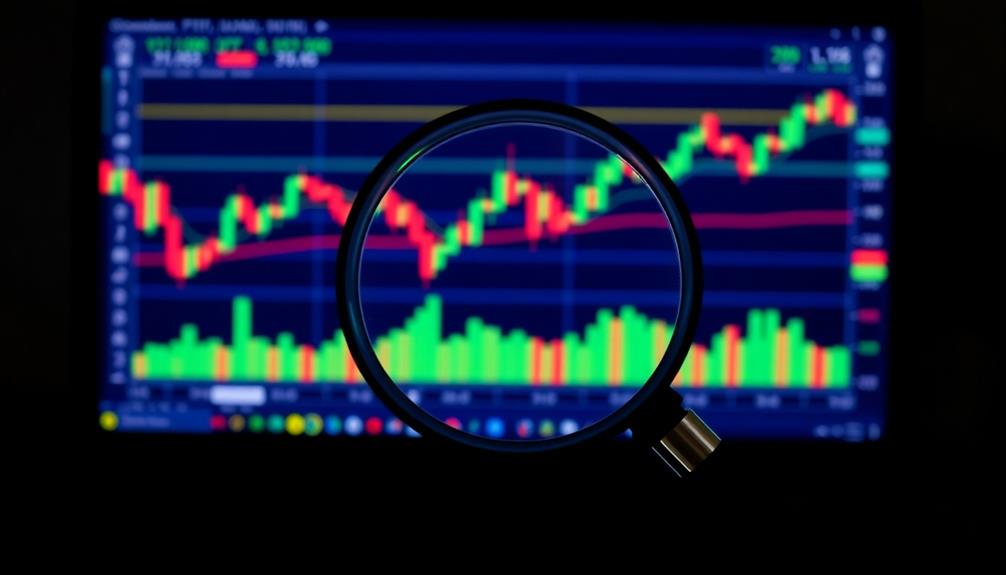
Understanding Volume Indicators
Insight into market dynamics is essential for successful crypto trading, and volume indicators provide just that. These tools measure the number of assets traded over a specific period, offering valuable information about market interest and activity levels. By understanding volume indicators, you'll be better equipped to confirm price movements and make informed trading decisions.
Key aspects of volume indicators in crypto trading:
- High trading volume often signals strong market interest
- Low volume may suggest weakness or uncertainty in a trend
- On-Balance Volume (OBV) combines price and volume data
- Volume Moving Average smooths out volume spikes
- Divergence between price and volume can indicate potential reversals
The On-Balance Volume indicator is particularly useful, as it shows cumulative buying and selling pressure. This helps you assess whether price movements are supported by volume.
Additionally, the Volume Moving Average can help you identify significant trends and potential reversals in price action by smoothing out volume spikes.
Pay attention to divergence between price movements and volume, as this can be a powerful indicator of trend reversals. For example, if prices are rising but volume is decreasing, it may suggest weakening buying momentum, potentially signaling an upcoming trend change.
Volume-Price Relationship
From the bustling streets of traditional finance to the digital highways of cryptocurrency, volume analysis remains an essential tool for traders. In crypto markets, understanding the relationship between volume and price is imperative for making informed decisions.
Volume-Price Relationship:
- Trading volume often indicates market interest and potential price movements.
- High volume accompanying significant price changes suggests a strong trend.
- Low volume during price shifts may signal lack of conviction in the move.
To interpret this relationship:
- Observe price charts alongside volume indicators.
- Look for confirming trends, such as rising prices with increasing volume (a bullish signal).
- Use the Volume-Weighted Average Price (VWAP) to assess if an asset is trading above or below its average price.
- Monitor volume spikes, which can help identify potential reversals or breakouts.
By analyzing volume in conjunction with price, you'll gain deeper insights into market dynamics. This approach allows you to:
- Validate the strength of trends
- Spot divergences between price and volume
- Anticipate significant price changes
Combining Multiple Chart Elements
Combining multiple chart elements is a powerful strategy for crypto traders seeking a thorough market analysis. By integrating various technical indicators, candlestick patterns, and chart analysis techniques, you'll gain a comprehensive view of market conditions and improve your decision-making process.
This approach allows you to:
- Identify trends and potential reversal points
- Confirm the strength of market movements
- Predict future price movements with greater accuracy
- Analyze both macro and micro-level market dynamics
- Make more informed trading decisions
Start by overlaying moving averages on your price charts to spot trends. Then, incorporate volume analysis to gauge market strength. High volume during price movements often validates a trend's legitimacy.
Next, examine chart patterns like head and shoulders or triangles in conjunction with momentum indicators such as the RSI. This combination can enhance your ability to predict future price movements.
Finally, analyze multiple timeframes to identify macro trends while making micro-level decisions. By combining these elements, you'll develop a well-rounded perspective on market dynamics.
Frequently Asked Questions
How to Analyse Crypto Charts for Beginners?
To analyze crypto charts as a beginner, you'll want to start by familiarizing yourself with different chart types, such as line, bar, and candlestick charts.
Pay attention to key data points like open, high, low, and close prices, as well as trading volume.
Utilize various timeframes to gain different perspectives on price action.
Learn to recognize common chart patterns and incorporate technical indicators like RSI and MACD.
These tools will help you identify trends, potential reversals, and market momentum, enabling more informed trading decisions.
How to Learn Crypto Trading Step by Step?
To learn crypto trading step by step, you'll want to:
- Start with cryptocurrency basics and blockchain technology.
- Study different types of crypto charts and their interpretations.
- Practice reading candlestick patterns for market insights.
- Open a demo trading account to gain hands-on experience.
- Stay informed through community engagement and market news.
By following these steps, you'll build a solid foundation for crypto trading.
How Do You Read Crypto Patterns?
You're about to reveal the secrets of crypto patterns. To read them effectively, you'll need to:
- Understand candlestick formations
- Recognize key patterns like “Shooting Star” and “Head and Shoulders”
- Analyze trading volume alongside price movements
- Utilize technical indicators such as RSI
- Examine patterns across multiple time frames
By mastering these skills, you'll gain valuable insights into potential market trends.
How Do I Start Understanding Crypto?
To start understanding crypto, you'll want to:
- Research basic blockchain technology and its applications
- Familiarize yourself with major cryptocurrencies like Bitcoin and Ethereum
- Learn about crypto wallets and exchanges
- Study market trends and factors influencing crypto prices
- Explore different investment strategies, such as HODLing or day trading
- Stay informed through reputable news sources and community forums
- Practice with small investments or demo accounts
- Consider taking online courses or attending workshops to deepen your knowledge
Conclusion
As you navigate the crypto sea, charts are your compass and map. You've learned to read the tides of candlesticks, interpret the winds of timeframes, and spot the islands of support and resistance. Armed with technical indicators and pattern recognition, you're better equipped to sail these volatile waters. Remember, no sailor becomes an expert overnight. Practice decoding charts regularly, and you'll gradually transform from a novice into a seasoned crypto navigator, ready to weather any market storm.











